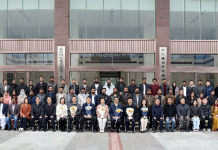BEIJING: When I got a job in China, my first thought was of the things I would love to do there: visit Tibet Autonomous Region, climb the Great Wall, ride the magic Sky Train which hurtles through air suspended from the rails and three of whose carriage sides are of glass… But never in my wildest dreams did I imagine that I would become an online “star,” selling things live!
Yet that is what I found myself doing in September, three months before the deadline for eradication of absolute poverty in China.
To give you an idea of the size of China’s e-commerce market, it’s been the largest in the world for seven consecutive years, according to a report by China Internet Network Information Center in September. In the first half of this year, this market notched up a stupefying 5.15 trillion yuan ($736.7 billion) in online sales. Buying and selling things online has become a way of life, from cities to remote villages.
This has been made possible due to the drive to build infrastructure, from roads in villages to telecom towers; innovation in technology including digital payments; and the flourishing of online retail platforms like JD.com and Taobao.
During my stay in China, e-commerce embraced a new trend, live-streaming.
Sitting in your little stall or a studio in a small village you can show your products to millions of people around the country and even across the borders, answer their queries, and they order goods and pay immediately.
Face of inclusion: Live-streaming especially showed its usefulness during and after the novel coronavirus disease (COVID-19) epidemic, becoming a potent tool to kickstart the economy.
One of my favorite memories is of Li Qiang, Deputy Mayor of Wuhan, the city in central China where the first COVID-19 cases were reported, taking part in his first live-streaming on April 8, when Wuhan reopened after a long lockdown.
Li, wearing a mask, talked about his favorite hot and dry noddles, a typical Wuhan delicacy. He urged viewers to buy them and other local products to put the economy back on its feet and on the first day of the campaign, according to media reports, nearly 300,000 items worth 17.9 million yuan ($2.7 million) had been sold.
So when Beijing Review started making a series of videos this year to highlight the factors behind the success of the poverty alleviation campaign, live-streaming was chosen as one of the subjects. However, this time we were not just going to report on the trend but be part of it.
It was the brainwave of Li Nan, our web editor, who had conceived of the series. Her reason was very simple. And touching.
“As a reporter, I have been to many poverty-stricken rural areas and written about their efforts to rise from poverty,” she told me. “But I want to do something more hands-on instead of remaining an onlooker. Since live-streaming is an effective way for farmers to reach the market in the aftermath of the epidemic, let’s do one to sell their products.”
– The Daily Mail-Beijing Review News exchange item






